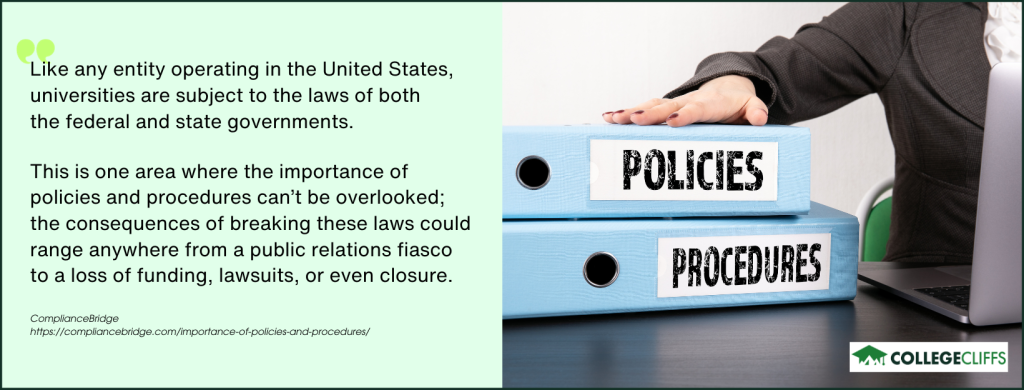10 Landmark Laws and Policies Impacting Higher Education
Find your perfect college degree
Since 1636, when Harvard College was established, higher education in the United States has been in constant flux, thanks to a combination of changes in society, culture, and technology. Many of the significant transformations were brought about by landmark laws and policies that influenced the quality, accessibility, and affordability of higher education.
These historic laws covered a wide range of issues in higher education, too, from civil rights to student rights, and the effects of these laws continue to be felt today.

Current Higher Education Landscape in the U.S.
In the United States, education is a defining feature of society in general and civic life in particular. From the days of the Founding Fathers, when an educated citizenry was emphasized for its crucial importance in a democratic society, to modern times, when education is closely associated with social mobility, civic engagement, and economic prosperity, a college education is highly valued.
The higher education industry has its fair share of attention, both positive and negative, because of its high value in American society.
But as with any industry, the education industry has also undergone changes, most of which strengthened its crucial place in American society. At present, the education industry is highly decentralized, meaning the federal government and its agencies have limited roles in the direct oversight and control of education at the municipal and state levels.
This is due to the Tenth Amendment, where the states have power over education and the deeply ingrained belief in local control, and it makes the U.S. education system fairly unique among nations for this reason.
Through the years, the higher education policies of the US have been closely linked to the goals of public education. These include preparation for citizenship, the cultivation of a skilled workforce with knowledge and skills relevant to the global marketplace, and teaching cultural literacy and critical thinking.
Nowadays, the higher education industry faces several major issues, of which the choice of a college and academic performance are among the most notable. Colleges and universities, federal and state governments, and stakeholders, including parents, students, and reform groups, can be at odds about education policies, from standardization of academic instruction to funding for programs.
In all these changes and issues, the U.S. Department of Education stands guard with its 4,400 employees – the smallest staff component among Cabinet-level departments – and the third-largest budget.
Higher Education Issues with the Potential for Profound Impact on Policy in the Future

In 2024, the higher education industry faces issues that can be hot-button issues during the presidential election if these already aren’t so. The current and prospective policies that relate to these issues will likely have an impact on the youth vote in particular – and with around 20.3 million undergraduate students, it’s quite an impact.
First, student loan debt relief is foremost on the minds of parents and college students for good reasons. In 2024, about 92% of the $1.75 trillion total student loan debt will be federal student loans; the rest are private student loans. Every student borrower was in debt for $28,950 on average. President Biden has been unsuccessful so far in his quest for student loan forgiveness.
Second, college affordability remains a contentious point, particularly with the ballooning cost of a college education. When adjusted for inflation, the tuition and fees at national universities have increased between 38% and 40% for the 2004-2024 period! President Biden has proposed free community college, among other possible measures.
Third, the increasingly common presence of online-only colleges and online-only academic programs is attracting more attention among policymakers and lawmakers. The possibility of changes in the definition, scope, and requirements of distance education programs will have a significant impact on colleges, universities, and their students.
Other possible transformational issues in higher education with potential for landmark impact are college students earning money from their name, image, and likeness; the extension or non-extension of the workforce Pell grants; and the adoption of diversity, equity, and inclusion (DEI) initiatives in colleges. There are also issues about LGBTQ restrictions, regulations on artificial intelligence, and prohibition on legacy admissions.
Landmark Laws and Policies With Significant Impact on Higher Education

Morrill Land-Grant Acts (1862 and 1890)
The Morrill Acts were instrumental in the establishment of land-grant universities and the expansion of higher education in the United States. Named after Justin Smith Morrill, who believed that higher education must be made accessible to the general public and must teach practical skills, the acts enabled states to establish public colleges and universities on federal lands (1862) or from proceeds of the sale of federal lands (1890). Note that the federal lands were often the result of the expropriation of Native American tribal lands through treaty, cession, and forcible seizure.
It was on July 2, 1862, that the Morrill Act of 1862—with more than 10 million acres allocated—was signed into law by President Abraham Lincoln. The land-grant colleges and universities created under the law emphasize agriculture and the mechanical arts. These institutions opened their doors to thousands of farmers and the working class, most of whom were previously barred from higher education.
The Morrill Act of 1890, also called the Agricultural College Act of 1890, expanded access to higher education for people of color, particularly in the former Confederate states where racial discrimination in schools required rectification.
Under the act, states were required to either create land-grant colleges for people of color or demonstrate admission without regard to race. The likes of Tuskegee University, Prairie View A&M University, and Alabama A&M were its results.
Today, the expansive land-grant university system consists of more than 100 institutions, including Penn State, the University of Arkansas, and Purdue University. The Morrill Acts also pioneered the passage of laws establishing the sea-grant, space-grant, urban-grant, and sun-grant colleges.
Servicemen’s Readjustment Act (1944)
Popularly known as the G.I. Bill, the Servicemen’s Readjustment Act of 1944 provided World War II veterans returning from active service a wide range of benefits intended for their adjustment to civilian life.
These services covered both financial support and non-financial services for the purchase of homes and businesses, hospitalization and unemployment insurance, and access to higher education. Such was its impact that the number of Americans with bachelor’s degrees and higher increased by 20% in 50 years!
President Franklin D. Roosevelt signed the GI Bill into law on June 22, 1944. Since then, its impact on higher education in particular and society in general continues to be felt, especially with more related laws passed. Indeed, the G.I. Bill expanded access to higher education for veterans and active military members, and that, to this day, continues!
The Post-9/11 G.I. Bill of 2008, for example, provides veterans on active duty on the 9/11 attack or afterward to receive educational benefits and transfer their unused benefits to their spouses or dependents.
The 2017 Forever G.I. Bill, or Harry W. Colmery Veterans Educational Assistance Act, further expanded the educational benefits for veterans (e.g., authorizing work-study programs, removing the Post-9/11 G.I. Bill 15-year limitation).
Civil Rights Act (1964)
Enacted by President Lyndon B. Johnson, the Civil Rights Act of 1964 is considered among the most significant legislative achievements in the history of the United States. The landmark Civil Rights & Labor Law outlawed discrimination and segregation based on race, color, sex, religion, and national origin in public places and accommodations, among other provisions.
The specific sections related to education are:
- Title IV, wherein the Attorney General has the official authority to address equal protection violations based on color, race, sex, religion, and national origin in public schools as well as colleges, universities, and other higher education institutions. The actions include filing lawsuits toward the enforcement of the act.
- Title VI, where recipients of federal funds, including colleges or universities, are prohibited from discrimination based on race, color, and national origin.
- Title IX permits the United States government to intervene in official matters related to pending discrimination-related lawsuits.
While many statutes prohibiting discrimination in education settings have been enacted after the Civil Rights Act of 1964, it’s considered the most seminal law for its revolutionary influence. Such was its impact in removing the barriers to educational opportunity. Its impact extended not just to African Americans but also to other people of color, sexual orientation, and age!
Higher Education Act (1965)
Yet another act enacted by President Lyndon B. Johnson, the Higher Education Act of 1965, strengthened the country’s higher education system in many ways.
First, colleges and universities were provided greater access to federal resources that enhanced their academic programs, community service programs, and continuing education programs. Said access also covered funding for improved library instruction and programs.
Second, colleges and universities received support for their cooperative agreements, a significant move that resulted in increased collaborations between institutions. The act also established the National Teacher Corps, which sought to address the teacher shortage in underserved institutions.
Third, the financial barriers that prevented individuals from pursuing higher education were significantly removed through financial aid.
The act demonstrated the federal government’s coordinated efforts in addressing the education gap through student aid, most of which are still in effect today. These are the Pell grants, direct subsidized, and direct unsubsidized loans, which millions of undergraduate and graduate students have benefited from since their establishment.
Indeed, making college education more affordable for low-income to middle-income Americans is the act’s most far-reaching provision.
The Higher Education Act has been reauthorized numerous times since its enactment in 1965 – in 1968, 1972, 1980, 1986, 1992, 1998, 2008, 2020, and 2022.
Title IX of the Education Amendments (1972)
“No person in the United States shall, on the basis of sex, be excluded from participation in, be denied the benefits of, or be subjected to discrimination under any education program or activity receiving Federal financial assistance,” mandates Title IX of the Education Amendments of 1972.
The amendment covered colleges and universities with federally-funded education programs. While the Civil Rights Act of 1964 also prohibited sex-based discrimination, the amendment further promoted gender equality in colleges and universities, particularly in the prevention of sexual harassment against women and in their improved access to athletic/sports programs.
Indeed, the number of female students engaged in organized athletics and sports activities in institutions considerably increased after its passage. The athletic budgets for women’s collegiate sports have also grown since its introduction, from about 2% of the total athletic budget to nearly 50% today.
The passage of Title IX is also credited for increasing the number of women in law and medicine, among other professions previously seen as male domains. In 1972, only 9% of women received medical degrees, while it was 7% for law degrees. By 1994, the figures increased to 38% and 43%, respectively.
In the 1970s, the term “on the basis of sex” referred to females, but the impact of Title IX carries on in the 21st century! Today, the term also refers to sexual preference, gender identity, and gender roles.
Family Educational Rights and Privacy Act (1974)
In the 21st century, when privacy rights are buzzwords, the Family Educational Rights and Privacy Act of 1974 was a pioneer!
FERPA is a federal law that provides comprehensive coverage for the protection of the privacy of student education records. It is a law that applies to both public and private schools at the elementary, high school, college and post-secondary levels, as well as to state and local education agencies receiving funds from the U.S. Department of Education.
The act serves two primary purposes:
- It provides parents and eligible students greater control over the information contained in their education records and the release thereof and,
- It prohibits schools from making disclosures about “personally identifiable information in education records” without either the parents’ consent in the case of a minor student or the eligible student concerned.
Note that an eligible student is either an individual who attends a post-secondary program (i.e., beyond the high school level) or who is at least 18 years old.
The parents’ and students’ rights include the inspection of review of the concerned student’s education records, usually the original records, unless the school must provide copies (i.e., due to considerable geographical distance).
The parents or the concerned student can request for correction of potentially misleading or inaccurate information on the education records and have the right to a formal hearing upon the school’s refusal.
But there are permitted disclosures wherein written consent isn’t necessary, such as the release of information to accrediting organizations, to concerned authorities in case of safety and health emergencies, and in compliance with subpoenas and other judicial orders. Student medical treatment records, however, are covered by FERPA, not HIPAA.
Americans with Disabilities Act (1990)
The Americans with Disabilities Act of 1990 does not allow disability-based discrimination. While there were already discrimination-related laws before its enactment – the Individuals with Disabilities Education Act covered K-12 programs, and Section 504 covered accessibility for blind students – these weren’t enough.
The ADA further emphasizes that disabled individuals must have full access to the employment opportunities offered by the public and private sectors, including colleges and universities.
The civil rights guarantee under the ADA mandates colleges, universities, and other higher education institutions, among others, to make “reasonable accommodations” in their employment process that ensure non-discrimination based on disability.
These reasonable accommodations should cover every aspect of employment, from recruitment, application and employment to compensation, promotion and termination.
These include but aren’t limited to:
- Active recruitment for open positions
- Modifications in the employment exams and interview questions
- Modifications in the training policies, processes and materials
- Provision of technology and other appropriate measures to allow employees with disabilities to become productive in their work
As a result of public awareness and attention, colleges and universities expanded their view of access for disabled students to include their academic programs, facilities and amenities in addition to employment.
Student Right-to-Know Act (1990)
Enacted by President Bush, the Student Right-to-Know Act amended the Higher Education Act of 1965’s Section 485. In it, colleges and universities that receive federal funding, including federal student aid, are required by law to disclose information about their graduation or completion rates to prospective and college students upon their request.
These institutions are also mandated to provide specific information about their student population and their student-athletes’ graduation or completion rates to the U.S. Department of Education and other individuals identified in the act.
Prospective students and their parents can then make more informed decisions about the colleges and universities they are interested in enrolling, thanks to the act. Graduation or completion rates are important factors because these are indicators of success for an institution, particularly for the quality of its academic programs, student engagement and overall student satisfaction.
These figures suggest that the college provides students with the necessary support services, learning resources and a conducive learning environment that contribute to the completion of their studies.
The Clery Act, or the Jeanne Clery Disclosure of Campus Security Policy & Campus Crime Statistics Act, is also notable for its impact on higher education. It mandates higher education institutions that receive federal funding to publish an annual campus security report and maintain a crime log, provide information about their campus security policies and procedures, and provide timely warnings to students and the campus community.
The Higher Education Amendments (1998)
Enacted by President Clinton, the Higher Education Amendments of 1998 made a huge impact on higher education in four ways. Note that the Higher Education Act of 1965 is reviewed every five years.
- The amendments decreased the student loan interest rate, which, in turn, lowered the cost of a college education and enabled students with student loan debt greater capacity to repay. The act extended for five years the 7.46% student interest rate – the previous rate was 8.25% – and allowed borrowers a four-month window in refinancing their outstanding loans.
- The act launched GEAR UP, a national initiative based on President Clinton’s High Hopes for College initiative that aids disadvantaged families and their children in preparing for college. GEAR UP provides grants to colleges and universities that establish partnerships with high-poverty middle schools and communities toward college preparation. These include providing relevant early information about financial aid for a college education and long-term counseling, tutoring and mentoring services, among others.
- The amendments included measures for improved teacher preparation programs, particularly in their teaching skills, knowledge about their academic content areas, and use of technology for teaching and learning purposes. The act also supported the recruitment of additional teachers, state-level initiatives for teacher quality improvement, and accountability in teacher education. Teachers who serve for five years in low-income communities can also apply for loan forgiveness up to $5,000.
- The act promoted high-quality distance education through the Learning Anytime Anywhere Partnership (LAAP) initiative, a program that awards grants to institutions involved in distance learning programs. More importantly, the act expanded the eligibility of distance learners, including non-traditional students (e.g., full-time workers, people with disabilities, people in rural areas, and parents) for student aid.
Affordable Care Act (2010)
The PPACA or Patient Protection & Affordable Care Act of 2010 made an impact on higher education by increasing federal funding for community colleges and increasing access to healthcare insurance for college students through Medicaid expansion. Before its enactment, young people, including college students, were the most uninsured age group.
When it was passed into law, the uninsured rate among the 18-to-34-year-old population decreased by 15% between 2010 and 2020 (i.e., from 29% to 14%). There was also an increase in the number of students enrolled in Medicaid, as it was for employer coverage for students, more likely thanks to the provision of dependent coverage. Students of color particularly benefited from PPACA – the gap between students of color and white students in terms of insurance coverage was approximately cut in half.
But it wasn’t just in quantitative terms either. The standards for student health insurance were raised after its passage, particularly in terms of increased industry regulation and improved insurance coverage.
The Student Loan Reform Act (2010), which is part of the PPACA, is also notable for putting an end to the Federal Family Education Loan Program (FFELP). Furthermore, it launched income-driven repayment plans and made the federal government the primary source for student loans.
Additional Information:




